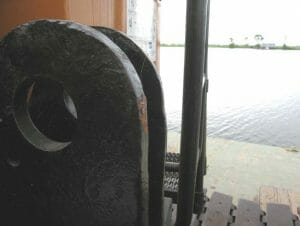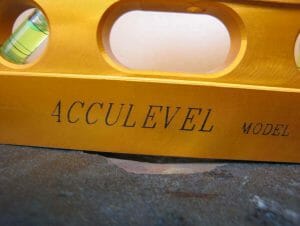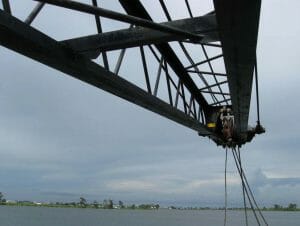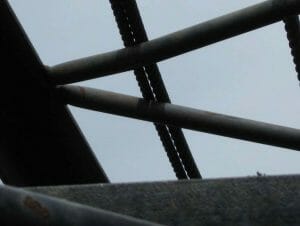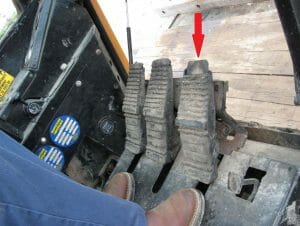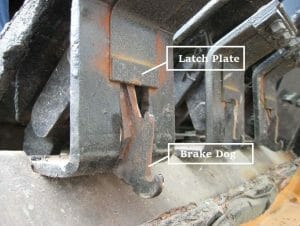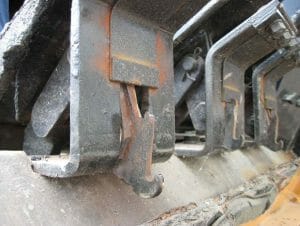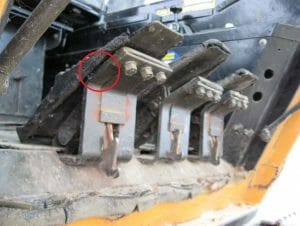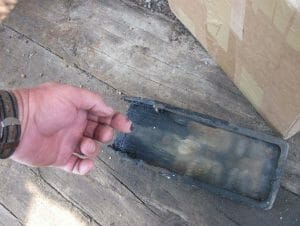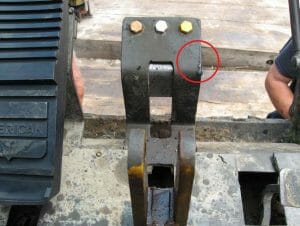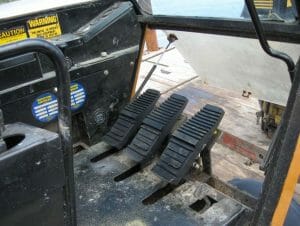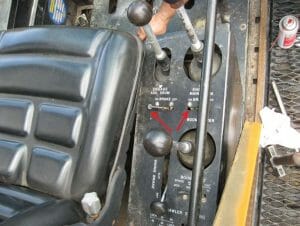U.S. Forensic conducted a crane failure evaluation. We were asked to inspect an American 5300 crawler crane. When the crane released a load, it caused the main boom to “whiplash.” The whiplash effect reportedly caused damage to the heel and tip sections of the main boom. The crawler crane was operating on pontoon barges located at an environmental research station. U.S. Forensic was retained by a dredging company to evaluate the damage to the boom and to determine the cause of the reported damages. Mr. Michael DeHarde, P.E. was the lead engineer on this project. Mr. DeHarde is a graduate of the University of New Orleans with a Bachelor of Science Degree in Engineering Sciences, Mechanical Engineering Option. He is licensed in 15 states.
Case Background
The American 5300 crawler crane was installing sheet piling and battered H-piles for a new bulkhead and dock for a university research center. It was reported that the crane had finished with pile driving for the day and the pile hammer and leads were elevated above the deck of the barge when the brake released the hoist drum and hammer with the leads dropping to the deck 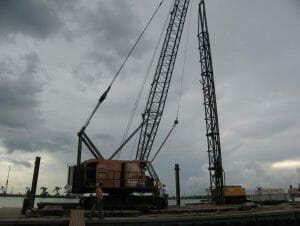 of the barge. Upon release, the crawler crane main boom “whiplashed” and caused the main boom to impact the lifting padeyes at the base of the boom above the heel pins. The boom also reportedly impacted the top of the leads which reportedly caused a dent in the bottom angular chord of the main boom. According to the dredging company, this was the third incident involving the sudden release of the brake holding the hoist drums.
of the barge. Upon release, the crawler crane main boom “whiplashed” and caused the main boom to impact the lifting padeyes at the base of the boom above the heel pins. The boom also reportedly impacted the top of the leads which reportedly caused a dent in the bottom angular chord of the main boom. According to the dredging company, this was the third incident involving the sudden release of the brake holding the hoist drums.
Crane Failure Evaluation
Main Boom Damage
- View of the padeyes above heel pin on superstructure.
- View of the dents on heel section.
- View of the underside of tip section.
- View of dented lacing.
The engineer observed dents in the structural steel top chord of the heel section of the main boom consistent with impacts to the padeyes on the upperworks or superstructure of the crane. The left hand side top plate was dented in a concave approximately 0.125 inches deep maximum, 1.625 inches wide, and 2.125 inches long. The right hand side top plate was dented in a concave 0.25 inches deep maximum, 3.125 inches wide, and 3.75 inches long.
On the tip section of the main boom, the engineers observed that the number 7 diagonal lacing (from head of the tip) on the top panel had a 0.50 inch maximum bend located 6 inches from the chord edge. The length of the bend was 21 inches long. On the bottom panel of the tip section, there were two dents, one in each of the bottom angular chords. The dents were 62 inches to 67 inches from the head assembly of the tip and each were 4 inches to 8 inches long. The dents were 0.50 inches deep each.
Inspection & Testing of Brakes
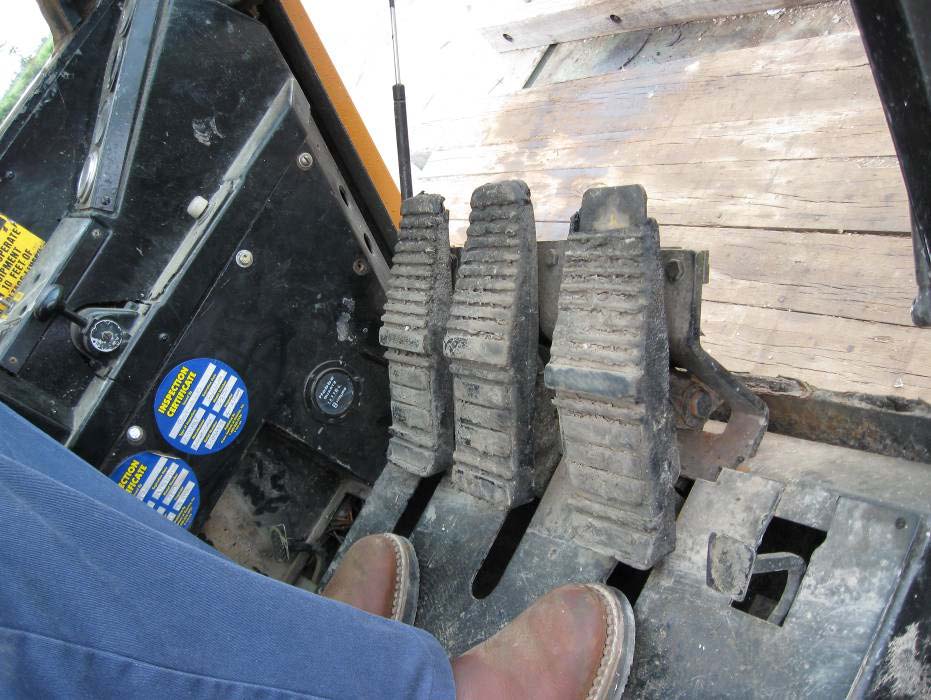
As part of the crane failure evaluation, the engineer tested the operation of the foot pedals in the operator’s cab. Sometimes, when the air brake valve for the main hoist drum was released, the right foot brake pedal dog caught on the latch plate and maintained the brake on the main hoist drum. At other times, especially after the air brake valve was applied for some period of time, the right brake pedal dog did not catch on the latch plate, causing the brake on the main hoist drum brake to not be maintained. This allowed the main hoist rope to play out and suddenly lower the load.
The rubber pads on top of the steel brake pedals were extremely worn and loose fitting. The tops of the rubber pads were completely worn away. The underside of the rubber pads revealed a black, sticky substance. The operation of the brake arm was in an angular motion out of the plane of the floor board with the brake pedal at one end of the arm and the reach rods connected to the other end. The pedal and pedal dog were designed for the toe of the pedal to rotate upward upon pedal release. The engineer observed that the sticky substance on the bottom of the rubber brake pad on the right brake pedal would stick to the pedal latch bracket and occasionally prevent the brake pedal from rotating properly. The longer the sticky substance was in contact with the latch plate bracket, the more likely the brake pedal would not rotate properly.
- View of foot pedals looking from inside of operators cab. Notice the extreme wear to the top of the right brake pedal pad.
- View of foot pedal latching plate.
- The brake pedals in the near ground and foreground are restrained by the air operated airing brake. The brake pedal in the center is mechanically latched.
- View of foot pedals looking into cab from front of crane. Circle is drawn around area of sticky substance.
- The sticky substance on the back and sides of the brake pad.
- The brake pedal was removed by the mechanic to make the repairs. The sticky substance on the latch plate bracket is within the circle.
- The new brake pads after repairs were made.
- The operator console with the brake valves. The auxiliary drum on the left and the main right and the right.
Analysis
The brake pedal dogs were designed to hook the latch plate and prevent the sudden and unintended release of the load should the air brake be released inadvertently. When the brake dog and latch plate operated correctly, the operator had to depress the brake pedal then rotate the brake pedal to release the dog which only then allowed the brake arm to move upwards to release the drum brake. When the brake pedal mechanism malfunctioned, simply moving the lever on the air brake valve slightly was enough to release the drum brake and drop the load.
The sticky substance was consistent with a maintenance effort to attach the brake pad to the steel pedal. Since the top of the rubber was worn off of the right brake pad, it appeared that the sticky substance was an adhesive added to the rear of the rubber brake pad. The substance migrated to the outside of the rubber pad and would stick to the latch plate bracket. When the mechanic removed the sticky substance and lubricated the pin, testing indicated that the brake pedal rotated properly.
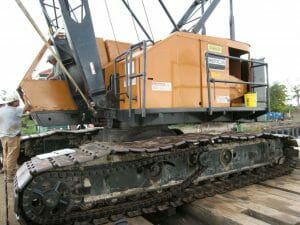 The evidence on the boom was consistent with the accounts of the event. The main boom “whiplashed” backward causing the heel section to contact padeyes at the base of the boom. The momentum of the impact caused the concave impressions in the top chords of the heel section of the boom. This resulted in structural damage to the main boom. The whiplash occurred when a heavy load on the boom was suddenly released. The sudden release of the load was consistent with the release of the drum brake that occurred when the pedal brake did not engage when the air brake valve was released. As a result of the malfunctioning brake pedal actuation a sudden release of the main drum brake allowed the wire rope to play out causing a drop of the load and sudden unloading of the boom. The sudden unloading of the boom caused the boom to impact the top of the leads which dented the bottom chord of the tip section and other damage observed.
The evidence on the boom was consistent with the accounts of the event. The main boom “whiplashed” backward causing the heel section to contact padeyes at the base of the boom. The momentum of the impact caused the concave impressions in the top chords of the heel section of the boom. This resulted in structural damage to the main boom. The whiplash occurred when a heavy load on the boom was suddenly released. The sudden release of the load was consistent with the release of the drum brake that occurred when the pedal brake did not engage when the air brake valve was released. As a result of the malfunctioning brake pedal actuation a sudden release of the main drum brake allowed the wire rope to play out causing a drop of the load and sudden unloading of the boom. The sudden unloading of the boom caused the boom to impact the top of the leads which dented the bottom chord of the tip section and other damage observed.
Conclusions of Crane Failure Evaluation
1. The physical evidence observed on the American 5300 crawler crane indicated that the main boom “whiplashed” backward causing the heel section to contact padeyes behind the heel section of the boom. The whiplash of the boom was caused by a sudden release of the load of the pile driving hammer and leads.
2. The physical evidence indicated that the sudden release of the load was a result of the release of the main hoist drum brake due to the malfunctioning of the brake foot pedal latch. When the operator released the air brake with the use of the pneumatic valve, the brake pedal lifted. This was due to the malfunction of the brake pedal latch such that the brake pedal dogs did not engage the latch plate. The malfunction of the brake pedal latch was caused by the application of a sticky substance on the bottom of the rubber pedal cover which interfered with the rotation of the brake pedal.
3. The conditions on the crane and the repeated malfunctioning of the foot pedal indicated that the faulty operation of the pedal was an ongoing problem at the work site.
Forensic Services
For more information about crane failure evaluations and other equipment failures, visit our heavy equipment page. For a complete line of forensic services.

